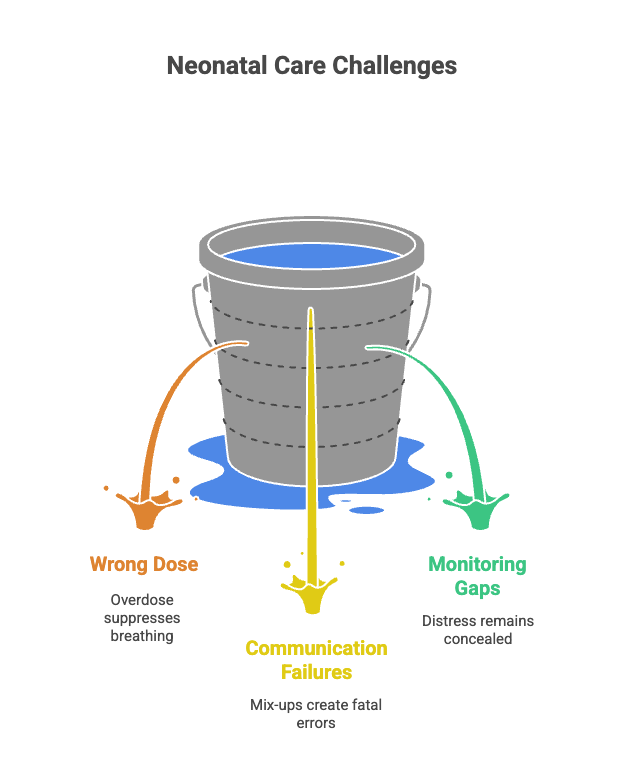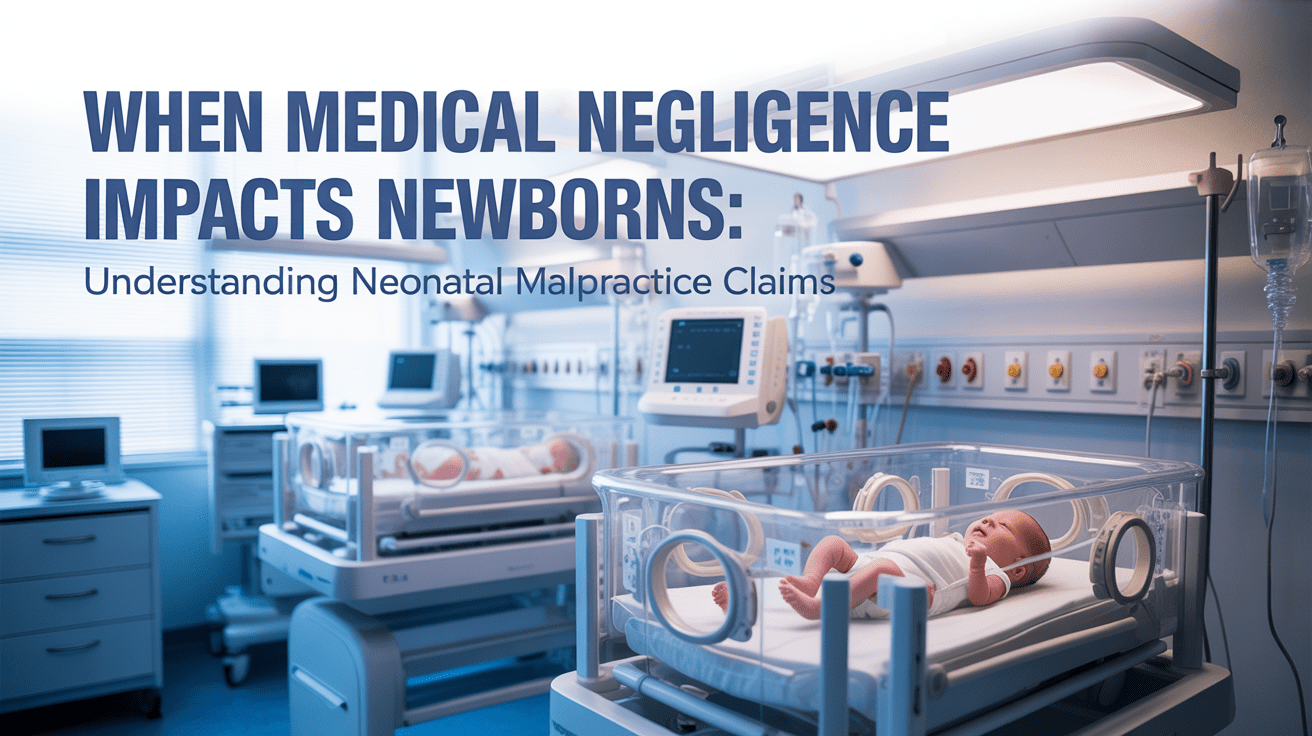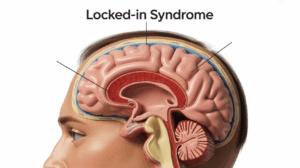Neonatal medical malpractice occurs when providers deviate from accepted labor, delivery, or newborn-care standards, causing preventable injury. Proving a claim requires showing duty, breach, causation, and damages, often supported by fetal-monitoring tracings, medication logs, and expert testimony.
Common errors include missed fetal distress, improper vacuum or forceps use, mismanaged shoulder dystocia, and medication or anesthesia mistakes.
Warning signs to watch for include low Apgar scores, unexplained bruising, fractures, nerve palsies, or indications of hypoxia.
Preserve all records, document timelines, seek an independent evaluation, and consider consulting the Law Offices of Anidjar and Levine to understand your options.
You can also learn more here: Florida Medical Malpractice Lawyer
What Is Neonatal Medical Malpractice?
Although newborn care often involves rapid, high‑stakes decisions, neonatal medical malpractice occurs when healthcare providers deviate from the accepted standard of care in labor, delivery, or the newborn period, and that breach causes preventable injury to an infant.
Neonatal malpractice arises when care deviates from standards, causing preventable newborn injury during labor, delivery, or postnatal care
You’re dealing with a legal concept that requires proof of duty, breach, causation, and damages.
In practice, you must show that qualified providers failed to act as reasonably careful clinicians would, and that this failure directly led to harm, such as a birth injury due to hospital negligence.
To protect your rights, consult a neonatal medical malpractice lawyer in Florida who understands neonatal standards, hospital policies, and expert‑witness requirements.
You’ll need medical records, timelines, and consultant opinions to address how to prove neonatal malpractice in Florida, including linking departures from protocols to specific injury outcomes.
If hypoxia or hemorrhage caused neurological harm, you may pursue compensation for neonatal brain injury, covering medical care, therapies, assistive needs, and future support.
Common Causes of Neonatal Injuries in the Delivery Room
You should recognize that delayed fetal distress response, including slow reactions to abnormal heart tracings, can lead to avoidable oxygen deprivation and lasting harm.
You also face risks when providers misuse vacuum extractors or forceps, or mismanage shoulder dystocia, causing fractures, nerve damage, or hypoxic injury.
Additionally, medication or anesthesia errors during labor can depress neonatal breathing, alter maternal signs, and compound delivery complications.
Delayed Fetal Distress Response
When warning signs on the fetal monitor aren’t recognized or acted on quickly, delayed responses to fetal distress can lead to preventable neonatal injuries. You depend on timely interpretation of heart rate patterns, oxygenation, and labor progress.
When clinicians miss late decelerations, abnormal variability, or prolonged bradycardia, medical errors during labor and delivery may cause hypoxia, acidosis, and brain injury. These lapses can justify a failure to monitor newborn oxygen levels lawsuit, especially if staff ignored protocols, delayed escalation, or postponed necessary delivery.
You should document the timeline, request full records, and consult an attorney for birth trauma and neonatal negligence. Prompt legal review helps link breaches to harm and quantify damages, including the long-term effects of newborn medical negligence, such as cognitive deficits and motor impairments.
Improper Vacuum or Forceps Use
Delayed responses to fetal distress often coincide with high‑risk interventions, and improper use of vacuum extractors or forceps can compound the danger. You face elevated risks when tools are applied with excessive traction, incorrect cup or blade placement, or repeated pulls after failed attempts. Such errors can cause skull fractures, intracranial hemorrhage, brachial plexus injuries, and facial nerve damage, while also injuring the mother.
You should expect clinicians to document indications, technique, number of pulls, and reasons for continuing or abandoning the procedure. When records are incomplete or inconsistent, negligence may be implicated. Preserve all medical documentation and seek an evaluation of causation and damages. An experienced Florida birth injury law firm can explain your legal rights after neonatal injury from negligence, coordinate expert review, and pursue accountability and compensation.
Mismanaged Shoulder Dystocia
Often overlooked until seconds matter, shoulder dystocia demands rapid, coordinated movements to prevent severe neonatal harm. When a baby’s shoulder lodges behind the pubic bone, your team must recognize the emergency, call for help, and follow safe, evidence-based steps. Proper management includes the McRoberts position, suprapubic pressure, delivery of the posterior arm, and rotational movements, while avoiding excessive traction on the head and neck.
Mismanagement can cause brachial plexus injuries, fractured clavicles, hypoxia, and, in severe cases, brain damage. Warning signs—maternal diabetes, suspected macrosomia, prior shoulder dystocia, or prolonged second stage—should trigger risk counseling, contingency planning, and heightened vigilance. Documentation should note timing, movements, forces applied, and neonatal condition. If providers deviate from accepted protocols, resulting injuries may reflect a breach of the standard of care.
Medication or Anesthesia Errors
Occasionally, a preventable medication or anesthesia error in the delivery room triggers catastrophic neonatal harm. You rely on clinicians to calculate weight-based doses, check allergies, and monitor fetal status, yet lapses can cause brain injury, respiratory depression, or cardiac instability. Wrong-drug administration, mislabeled syringes, or failure to reverse maternal anesthesia effects may deprive your newborn of oxygen at a crucial moment. Vigilant protocols, dual verification, and real-time monitoring should prevent these events, and their absence often signals negligence.
- Wrong dose or concentration: opioid or magnesium overdoses suppress neonatal breathing, while inadequate antibiotics or antivirals invite severe infection.
- Communication failures: indistinct verbal orders, look-alike packaging, and rushed handoffs create fatal mix-ups.
- Monitoring gaps: delayed pulse oximetry, capnography, or blood-gas checks conceal emerging distress.

How Medical Negligence Can Affect a Newborn’s Long-Term Health
When lapses in neonatal care breach accepted standards, a newborn can face injuries that shape health and development for years. You may see consequences that unfold gradually as your child grows, because the brain, lungs, and musculoskeletal systems are still maturing.
Oxygen deprivation can lead to cerebral palsy, cognitive delays, or epilepsy, while untreated jaundice may cause kernicterus with hearing loss and motor impairment. Improper infection control can result in sepsis, damaging organs and immunity. Traumatic delivery techniques can produce nerve injuries, such as brachial plexus palsy, affecting arm function.
These injuries often require lifelong therapies, including physical, occupational, and speech services, along with assistive technologies and focused education. You might also confront feeding issues, growth delays, and chronic respiratory or cardiac complications.
Over time, the financial burden can escalate due to recurrent hospitalizations, medications, and adaptive equipment. Understanding these potential trajectories helps you plan care, monitor milestones, and advocate for appropriate, evidence-based interventions.
Recognizing the Early Signs of Birth-Related Medical Negligence
You should watch for delayed recognition of fetal or newborn distress, especially when monitoring notes reflect prolonged abnormalities without timely intervention.
You must question unexplained neonatal injuries such as fractures, lacerations, or bruising inconsistent with the delivery account.
You also need to note abnormal Apgar scores or unstable vital signs that weren’t promptly addressed, as these red flags can indicate birth-related medical negligence.
Delayed Distress Recognition
Although labor can unfold quickly, delayed recognition of fetal or neonatal distress is a pivotal early sign of birth-related medical negligence that demands immediate scrutiny. You should expect your team to monitor fetal heart tracings, oxygenation, and maternal status, then act without hesitation when patterns deteriorate.
When staff miss persistent late decelerations, prolonged bradycardia, meconium, or poor Apgar scores, vital minutes are lost, and preventable harm can occur. Ask whether escalation protocols were followed, whether additional testing or expedited delivery was considered, and whether documentation accurately reflects events.
- Review continuous monitoring records for gaps, unexplained pauses, or ignored alarms.
- Identify delayed responses to abnormal tracings, non-reassuring Apgar scores, or cyanosis.
- Confirm timely consultations, activation of the chain of command, and informed communication with you.
Prompt legal guidance helps preserve evidence and evaluate causation.
Unexplained Neonatal Injuries
Despite the joy of a new arrival, unexplained neonatal injuries—such as bruising in atypical locations, fractures without a precise birth-related mechanism, nerve palsies, lacerations, or signs of hypoxia—should immediately prompt careful review for potential negligence.
You should ask for a detailed account of the delivery, including instrument use, traction applied, shoulder dystocia techniques, and staffing levels. Request complete records: labor notes, nursing charts, operative reports, fetal monitoring strips, and imaging.
Could you photograph visible injuries promptly and secure written timelines from witnesses?
When explanations are inconsistent or undocumented, treat that as a red flag. Seek an independent pediatric evaluation to differentiate unavoidable birth trauma from preventable errors. Preserve all communications in writing, and avoid speculative statements. Consult an experienced neonatal malpractice lawyer early to assess standard-of-care breaches, causation, and evidence needs.
Abnormal Apgar or Vitals
When a newborn’s Apgar scores are unusually low at 1, 5, or 10 minutes, or crucial signs show persistent abnormalities—such as poor tone, weak or absent respirations, bradycardia or tachycardia, hypotension, low oxygen saturation, or temperature instability—those findings can signal preventable distress and warrant immediate scrutiny.
You should expect rapid assessment, prompt resuscitation, and continuous monitoring, with clear documentation of every intervention and response.
If staff delay escalation, overlook abnormal trends, or fail to order appropriate labs and imaging, gaps in care may constitute negligence.
Preserve records, request fetal monitoring strips, and accurately note timelines.
Early legal counsel can coordinate experts to analyze causation and long-term outcomes.
- Obtain complete delivery records and neonatal flow sheets immediately.
- Track oxygen delivery, fluids, medications, and response minute by minute.
- Seek independent neonatology and neurology reviews without delay.
Who Can Be Held Liable in a Neonatal Malpractice Case?
Because neonatal care spans prenatal consultations through delivery and the newborn’s first days, liability can extend to any provider or entity that breached the accepted standard of care and caused harm.
You may hold individual clinicians accountable, including obstetricians, neonatologists, pediatricians, midwives, anesthesiologists, nurses, and respiratory therapists.
Liability can also reach hospitals, birthing centers, and NICUs for inadequate staffing, negligent supervision, unsafe policies, or credentialing failures.
You can pursue claims against on-call consultants who delayed consultation, lab or radiology personnel for testing errors, and pharmacists for compounding or dosing mistakes.
Medical groups, corporate parents, and staffing agencies may be responsible under vicarious liability when their employees or contracted clinicians err.
Device manufacturers and suppliers may be liable for defective monitors, ventilators, or infusion equipment used in neonatal care.
Finally, electronic health record vendors could share fault if system glitches, alert failures, or unsafe design contributed to miscommunication and preventable injury.
How Attorneys Prove Negligence in Neonatal Injury Lawsuits
You prove neonatal malpractice by first establishing the applicable standard of care through authoritative guidelines and qualified expert testimony.
You then show how the provider’s actions breached that standard, using detailed medical records, fetal monitoring strips, medication logs, and communication timelines.
Finally, you connect the breach to the infant’s injury with causation evidence, including expert opinions, differential diagnosis analysis, and a precise chronology linking omissions or errors to the harm.
Establishing Standard of Care
Although every neonatal case turns on its facts, establishing the standard of care is the fulcrum for proving negligence and liability. You must define what a reasonably prudent neonatologist, obstetrician, or NICU nurse would’ve done under similar circumstances.
Your attorney anchors this benchmark through authoritative guidelines, peer‑reviewed literature, and qualified experts who practice in the same specialty.
They compare protocols to the care your newborn received, identify deviations, and document precise clinical lapses, such as monitoring failures or delayed escalation.
- Identify the applicable specialty and care setting, then align duties with AAP, ACOG, and neonatal nursing standards.
- Retain board‑certified experts to interpret records, policies, and fetal monitoring data against consensus practices.
- Corroborate standards with institutional policies, credentialing files, and chain‑of‑command requirements to show expected responses and timeliness.

Causation Through Evidence
Defining the standard of care sets the benchmark; proving causation shows how departures from that benchmark produced your newborn’s injury. You establish causation by linking specific acts or omissions to measurable harm, using objective, corroborated evidence. Your attorney compiles prenatal, labor, delivery, and NICU records, then aligns timestamps with essential signs, fetal monitoring strips, medication logs, and nursing notes.
They retain qualified neonatology, obstetrics, and nursing experts to explain how hypoxia, infection, or medication errors biologically caused the injury, and to rule out alternative explanations. Differential etiology, timeline analyses, and imaging comparisons strengthen the chain of proof. Witness statements, internal incident reports, and communication records reveal decision points.
Finally, demonstrative exhibits—such as flowcharts, annotated tracings, and growth curves—translate intricate data into a straightforward, persuasive causal narrative.
Compensation Available for Families Affected by Neonatal Negligence
When neonatal negligence causes harm, compensation aims to cover both immediate losses and the long-term consequences your family faces. You can seek damages for past and future medical care, including surgeries, medications, therapies, and specialized equipment. Claims may include costs of in-home support, adaptive technology, and transportation to appointments.
If you miss work to care for your child, you can pursue lost wages, and when your earning capacity changes, you may claim future economic losses. Non-economic damages address pain, suffering, and loss of enjoyment of life for both you and your child, where permitted.
Compensation can cover medical expenses, lost income, and the lasting impacts of neonatal negligence.
- Medical and rehabilitative costs: neonatal intensive care, pediatric neurology, physical, occupational, and speech therapy, as well as assistive devices.
- Economic losses: past and future lost income, diminished earning capacity, and necessary household or respite care.
- Non-economic and special needs: pain and suffering, emotional distress, special education services, and home or vehicle modifications.
Structured settlements or trusts can safeguard long-term care and preserve eligibility for public benefits.
Why Choosing an Experienced Birth Injury Lawyer Matters
Because neonatal malpractice cases hinge on elaborate medicine and strict legal standards, choosing an experienced birth injury lawyer directly affects your outcome. You need counsel who understands neonatal care protocols, causation, and how deviations from the standard of care produce injury.
A seasoned lawyer interprets complicated medical records, consults credible experts, and isolates where negligence occurred. This precision strengthens liability arguments and prevents insurers from minimizing your claim.
An experienced attorney also manages procedural demands, including pleadings, discovery, and strategic use of expert testimony. They know how to frame damages to reflect present and future medical needs, specialized therapies, and the broader impact on family life.
Their command of deadlines and evidentiary rules protects your case from avoidable pitfalls.
You benefit from targeted negotiation and, when necessary, trial advocacy grounded in medical facts. By aligning legal strategy with neonatal medicine, an experienced lawyer maximizes accountability and positions you for fair compensation.
Steps to Take If You Suspect Your Newborn Was Harmed by Negligence
If you suspect negligence, you should promptly document your newborn’s symptoms and the care provided, noting dates, times, and provider names with precision.
Seek immediate medical evaluation to protect your child’s health and create objective records, and preserve all charts, test results, discharge summaries, and communications.
Then consult an experienced birth-injury attorney to assess causation and liability, coordinate expert reviews, and safeguard deadlines.
Document Symptoms and Care
Documenting your newborn’s symptoms and care creates a reliable record that protects your child’s health and preserves vital evidence.
Start immediately, and keep entries contemporaneous. Note visible signs, feeding patterns, sleep changes, temperature readings, and any unusual behaviors.
Record every interaction with providers, including the date, time, names, and instructions provided. Save discharge summaries, medication labels, dosing logs, and after-visit notes.
Photograph rashes, swelling, or devices in place, and annotate each image with time and context.
Maintain a single, organized file to prevent omissions and inconsistencies.
- Capture objective data daily: weight, temperature, input/output, oxygen readings, and pain indicators, with exact timestamps.
- Preserve all written and digital communications, including patient portals and voicemail transcriptions.
- Create a running timeline that links symptoms, provider directives, and interventions, highlighting any deviations or reversals in care.
Seek Immediate Medical Evaluation
At the first sign of unusual distress or regression, seek immediate evaluation for your newborn at an emergency department or from a qualified pediatric expert. Don’t wait for a routine appointment, because early intervention can prevent complications and clarify the cause of the problem.
Describe the timing of symptoms precisely, including feeding changes, abnormal tone, breathing difficulty, persistent jaundice, seizures, or lethargy. Request a thorough assessment that may include labs, imaging, and a consultant consultation.
Ask the treating team to explain differential diagnoses and whether any prior care could have contributed to harm. Communicate all medications, supplements, and prenatal or delivery events.
If you’re redirected or delayed, escalate respectfully and request a transfer to a facility with neonatal capabilities. Prioritize timely care, clear communication, and prompt follow-up with your pediatrician.
Preserve Records and Evidence
Prompt care sets the foundation; now protect your newborn’s claim by preserving every piece of information tied to the event. Secure complete copies of prenatal records, delivery notes, neonatal charts, medication logs, imaging, and lab results. Request written discharge summaries and obtain the fetal monitor strips and Apgar documentation.
Save all communications—texts, emails, portal messages—and photograph equipment, wristbands, and any visible injuries. Maintain an organized chronology with dates, times, names, and roles of staff present.
- Keep originals sealed; work only from copies, and note when and how each item was obtained to preserve authenticity.
- Back up digital files in multiple locations, using consistent filenames and date formats for traceability.
- Continue to contemporaneously journal symptoms, feeding issues, interventions, and provider statements.
Consult an Experienced Birth-Injury Attorney
Engage a seasoned birth-injury attorney as early as possible to evaluate whether negligence caused your newborn’s harm and to safeguard your family’s rights.
Early counsel helps you interpret medical records, preserve vital evidence, and avoid mistakes that can jeopardize your claim. An experienced lawyer promptly consults neonatal and obstetric experts, identifies breaches of the standard of care, and assesses causation linking errors to your child’s injuries.
You’ll receive guidance on immediate steps, including independent evaluations, documentation protocols, and communications with insurers. Your attorney manages filings and deadlines, protects privileged information, and coordinates expert testimony.
They also calculate damages, including future medical needs, therapies, adaptive equipment, and lost earning capacity. By retaining qualified counsel, you strengthen accountability efforts and position your family to secure fair compensation while focusing on your child’s care.
How Anidjar & Levine Support Families Through Neonatal Malpractice Claims
While neonatal cases demand both medical insight and legal precision, Anidjar & Levine guide your family through each step with focused advocacy and meticulous case-building.
We start by securing and analyzing complete medical records, then engage vetted neonatal and obstetric experts to assess breaches of the standard of care and causation.
We secure complete records and consult with neonatal experts to identify breaches of the standard of care and causation.
We preserve vital evidence early, coordinate independent evaluations, and map timelines that connect provider decisions to your child’s injuries.
You’ll receive structured guidance on documentation, benefits coordination, and medical liens, so treatment proceeds while your claim advances.
We quantify damages with precision, projecting future care, therapies, and assistive needs, while also addressing lost income and non-economic harms.
Throughout, we communicate clearly, prepare you for each milestone, and protect your rights.
- Thorough record audit, expert consultations, and causation analysis focused on neonatal protocols
- Early evidence preservation, spoliation notices, and targeted discovery planning
- Damages modeling for lifelong care, including therapies, equipment, and home modifications
Why Choose Anidjar and Levine
Choose Anidjar & Levine for a firm that pairs deep neonatal malpractice experience with rigorous litigation strategy and attentive client service. You’ll work with attorneys who understand neonatal medicine, causation, and hospital protocols, and who know how to translate intricate records into clear, persuasive evidence.
We coordinate with leading pediatric and obstetric experts, develop precise timelines, and preserve essential proof before it’s lost.
You receive proactive communication and responsive guidance, so you’re informed about strategy, filings, and deadlines at every stage. We evaluate liability, quantify damages, and pursue compensation for medical care, future therapy, lost income, and pain and suffering.
Our team manages subpoenas, depositions, and negotiations with insurers while preparing every case as if it will proceed to trial.
We adhere to strict deadlines and safeguard your rights, including confidentiality and informed consent issues. With focused preparation and disciplined advocacy, we position your claim for a strong, timely, and result.

Frequently Asked Questions
How Long Do We Have to File a Neonatal Malpractice Claim?
You generally have one to three years to file, but neonatal cases often involve special rules.
Many states toll the statute until the child reaches majority, while others use discovery rules starting when you knew or should’ve known of negligence.
Shorter deadlines may apply for claims against public hospitals.
Please act promptly to maintain records and comply with notice requirements.
Please consult an experienced malpractice lawyer as soon as possible to calculate your exact deadline and protect your rights.
Will Pursuing a Claim Affect My Child’s Ongoing Medical Care?
Pursuing a claim shouldn’t affect your child’s ongoing medical care. Providers must treat patients ethically, regardless of legal actions. You can continue your care, request transfers, or seek second opinions without fear of retaliation. Your lawyer will handle communications, protect confidentiality, and ensure that your treatment is not disrupted.
Meticulous documentation, expert reviews, and adherence to deadlines occur outside clinical settings. If conflicts arise, counsel can coordinate with alternative clinicians and facilities to ensure continuity, safety, and access to necessary therapies and follow-up care.
What Costs Does Your Firm Cover Upfront During the Course of the Case?
We typically cover filing fees, medical record requests, expert consultations, deposition costs, court reporters, and necessary travel for case development. You don’t pay these litigation expenses upfront; we advance them and seek reimbursement from any recovery.
Our firm also manages discovery costs, exhibits, and trial technology when required. Attorney fees are contingency-based, so you owe nothing unless we obtain compensation.
We provide clear, written terms and regular accounting of all case expenses.
Can We Seek Compensation if No Immediate Injury Was Apparent?
Yes, you can seek compensation if injuries surface later, provided you prove negligence, causation, and damages. Many jurisdictions apply a discovery rule, starting the statute of limitations when you knew or should’ve known of harm.
You should obtain immediate evaluations, preserve records, and document evolving symptoms. An experienced malpractice lawyer will coordinate expert reviews, establish the breach of the standard of care, link it to the delayed injury, and file within all deadlines.
How Are Medical Experts Chosen and Compensated in These Cases?
You and your lawyer select medical experts based on specialty alignment, board certification, clinical experience, and prior testimony credibility.
Your attorney vets conflicts, reviews publications, and conducts interviews before retention.
Experts are compensated through hourly fees for record review, reports, depositions, and trial testimony, as well as reasonable expenses.
You typically advance costs under a contingency agreement, and the lawyer recoups them from any recovery.
Courts may scrutinize qualifications and methodology under evidentiary standards.
——————–
You are entitled to clear answers and decisive action when negligence harms your newborn. By recognizing warning signs, documenting everything, and consulting a skilled birth injury lawyer early, you’ll protect your child’s health and legal rights.
The Law Offices of Anidjar and Levine can investigate records, secure expert reviews, identify liable parties, and meet strict deadlines.
With focused advocacy, you can pursue compensation for medical care, therapies, and long-term support.
Take the next step now with a knowledgeable team at your side: Florida Medical Malpractice Lawyer.











